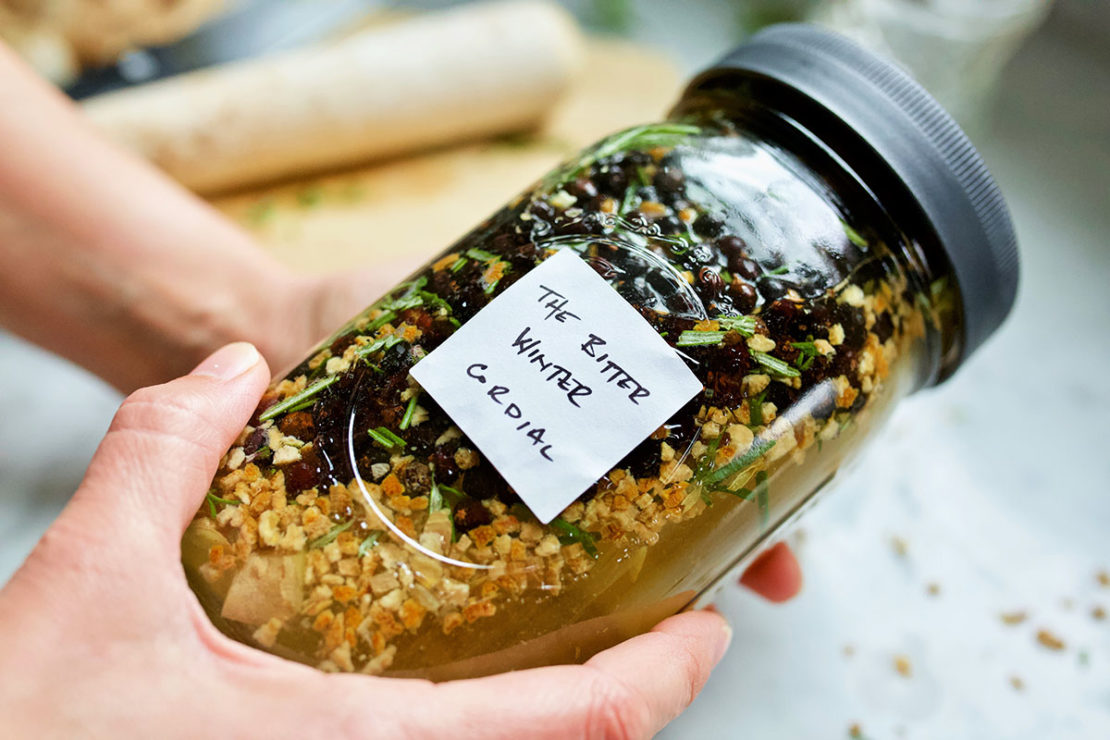
3 Conifer Cordial Recipes for Winter Wellness
The fresh scent and sight of conifers symbolize winter and the coming of colder months. Conifers have long provided habitat for animals and materials humans use for shelter, clothing, tools, and transportation, and they have also provided food for animals and humans as well. But did you know that they have also been used in herbalism?
There are numerous wellness benefits we can derive from conifers, and one fun way to incorporate these evergreens into your life is with cordials. Winter usually means shorter days and colder weather, and making conifer cordials can be a fun way to lift your spirits!
Here we will discuss three different types of conifer trees, their wellness benefits, and how to use them in three conifer cordial recipes!
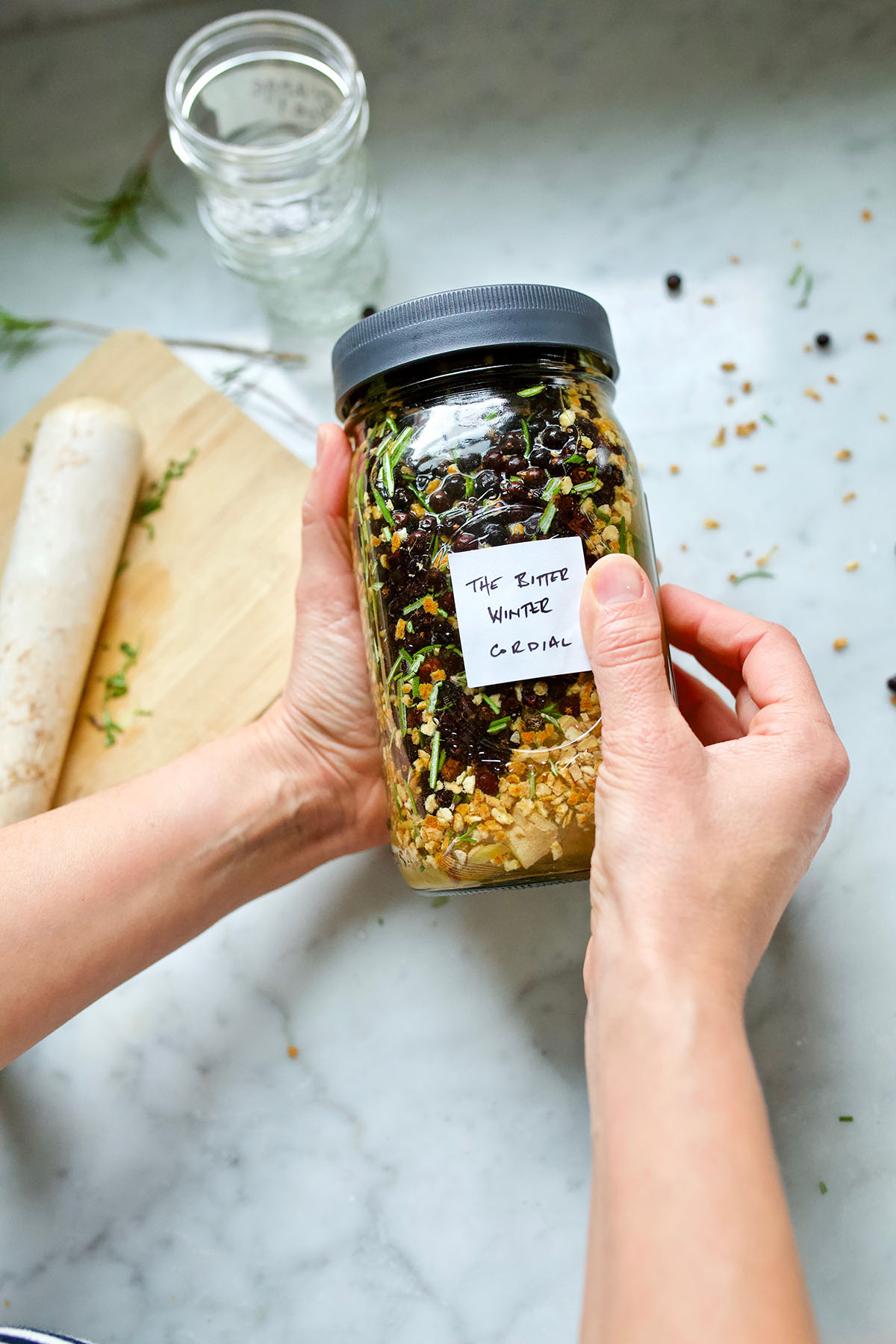
What Is A Cordial?
Cordials are a delicious and easy way to incorporate herbs into your daily life. A cordial is generally known as a sweetened culinary herbal tincture. A tincture is made by infusing herbs in any type of alcohol. Combining a tincture with honey or maple syrup produces an enticing herbal preparation with a long shelf life.
Depending on what is available, you may use fresh or dried herbs to make a cordial. When using fresh herbs, you will need to use a greater volume of fresh plant material since fresh herbs contain water and take up more space. When using dried herbs, you will use a lesser amount of plant material. The cordial recipes in this article suggest ingredient amounts for both fresh and dried herbs.

3 Beneficial Conifers For Winter Wellness
Conifer trees are classified as plants that have cones (American Conifer Society, 2017). These are typically trees with needles (or even shrubs) in temperate climates and are associated with being evergreen, though not every conifer is an evergreen (Lassoie et al., 1996).
While there are many conifer trees that are used traditionally for wellness, in this post, we will specifically discuss Western red cedar, Western juniper, and Douglas fir.
Before we share some of the wellness benefits of these three conifers, we want to first talk about being a sustainable herbalist and respecting plants and those for whom these trees are most significant. Many animals, fungi, and even other flora are accustomed to using these trees as food and habitat. There are also many traditions that hold these trees as especially sacred, perhaps in part because evergreens provide food and comfort even through the winter months.
There are many native tribes that have historically revered particular conifers. In North America, for example, the Bella Coola people have used Western red cedar for wellness, shelter, and clothing. Apache and Paiute tribes have used juniper berries to support wellness. Navajo tribes have used juniper berries for dye as well as for ceremonial use, and the Havasupai, Hopi, Isleta, Jemez, Keres, and Tewa tribes have a history of using Douglas fir for ceremonial purposes (Native American Ethnobotany, n.d.).
Do confirm that you are sourcing these plants respectfully and sustainably. You can choose to harvest these conifers yourself in a sustainable manner, or you can purchase them from local or online sources that support sustainable herbal practices. To learn more about being a sustainable herbalist, check out our article, How To Be An Environmentally Sustainable Herbalist.
Western red cedar (Thuja plicata) leaf tips
The aromatic and astringent evergreen leaf tips of the Western red cedar are commonly used to bring relief to hot, damp conditions in the body due to their cooling and drying effects (Kloos, 2017). Western red cedar is also well known for its strong antibacterial and antifungal properties, and herbalist Michael Moore recommended the tincture topically for various fungal conditions, such as tinea versicolor, jock itch, athlete’s foot, ringworm, and nail fungus (Moore, 1993). Western red cedar has also traditionally been used for acute or chronic respiratory ailments, mucus-heavy bronchial conditions, or urinary conditions, such as urinary tract infections (Moore, 1993). Western red cedar is an immunostimulant, and when taken in small doses for short periods of time, it may help the immune system to fight chronic respiratory and intestinal infections (Moore, 1993).
Western red cedar leaf tips are commonly prepared as a tea or tincture for internal use, or infused in an oil for topical use.
Safety: Western red cedar contains thujone, which is considered a uterine stimulant, so it is not appropriate to use during pregnancy. It is not recommended for consumption as a long-term tonic, because it can be damaging to the kidneys when used for long periods of time (Kloos, 2017).
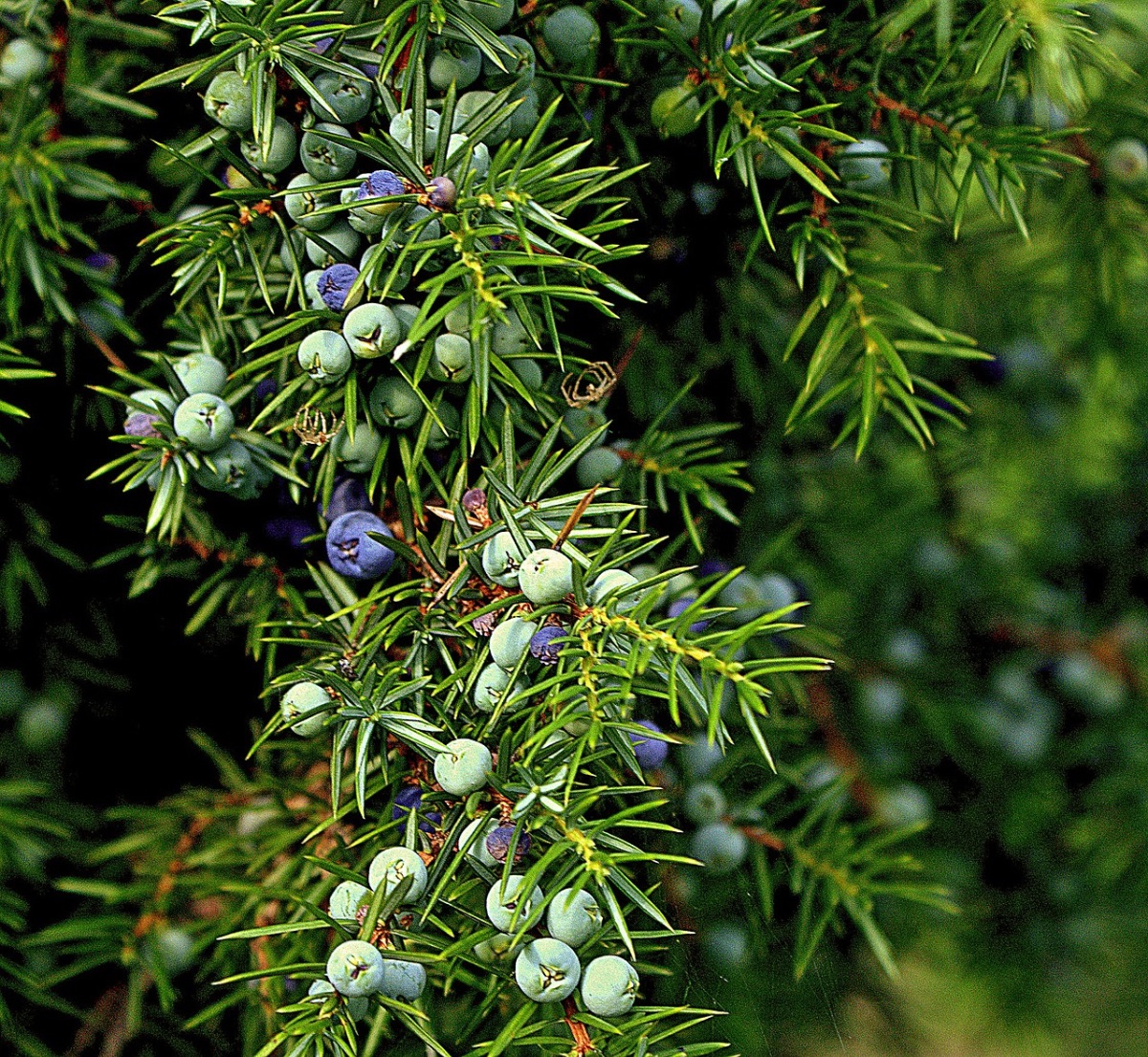
Western juniper (Juniperus occidentalis) berries
Juniper berries are commonly used for a wide variety of wellness concerns due to their antimicrobial properties, including chronic urinary tract infections, respiratory infections, and to cleanse and warm the kidneys in an energetic sense. As a diuretic, juniper berries stimulate the kidneys and bladder and help to tonify the entire genitourinary system, making it helpful for conditions like incontinence and stones (Pursell, 2015).
Juniper berries are also supportive to the digestive system since their bitter and carminative properties help soothe indigestion and gas (Kloos, 2017), and they contain flavonoids, calcium, magnesium, and vitamin C (Pursell, 2015).
Western juniper berries are commonly prepared as a tea infusion or tincture for internal use.
Safety: Juniper berries should not be used long-term, so do not consume them for more than 6 weeks. Due to their kidney-stimulating nature, they should not be used by those with kidney disease (Pursell, 2015).
Douglas fir (Pseudotsuga menziesii) leaf tips and resin
The leaf tips of the Douglas fir are highly astringent and can help ease intestinal upset and diarrhea (Kloos, 2017). The spring tips contain high amounts of vitamin C, which can help boost the immune system, therefore, and can be eaten fresh or brewed as a tea (Kloos, 2017).
An external wash can be made using hot water and leaf tips for cuts, abrasions, or burns. This hot water infusion helps to release the volatile oils from the needles, extracting their antimicrobial properties, which are commonly found in plants high in volatile oils. When trauma occurs to the bark of a Douglas fir tree, antimicrobial resin oozes out to protect the tree from infection (Langenheim, 2018). The resin has been used externally on wounds, to ease sore muscles, stave off infection, and due to the clearing nature of its volatile oils, as a chest rub for colds, flus, and congestion (Kloos, 2017).
Douglas fir leaf tips are commonly prepared as an infusion for internal and external use, and the resin is often infused in oil for external use.
Safety: There are no known safety precautions with Douglas fir.
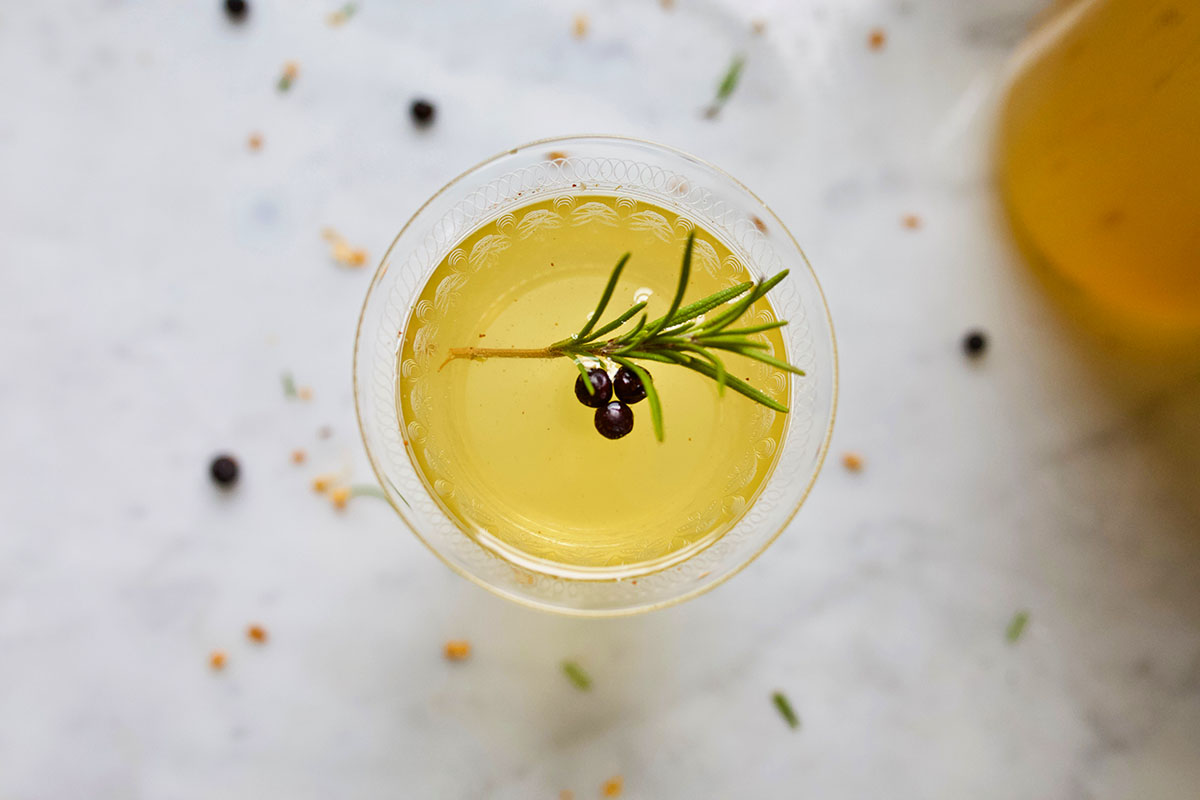
3 Conifer Cordial Recipes To Try This Winter
Now that you know about these three conifers and some of their wellness benefits, let’s look at how to use them in some cordial recipes during the winter months.
These cordials can be used to support wellness in the body or simply lift your spirits during the cold winter months. You can drink them straight, over ice, add to hot water to make a tea or herbal hot toddy, or you can mix them with your favorite sparkling water or beverage.
In the following recipes, you may use the recommended alcohol in the recipe, a different alcohol of your choice, or vinegar if you prefer to avoid alcohol. Vinegar mixed with honey is considered an oxymel, which could be enjoyed as a beverage or even as dressing or a marinade.
Storage: Cordials are viable for many years due to their high alcohol content, however, using fresh herbs decreases the shelf life due to the water content contributed by fresh plant material. When using fresh ingredients, the cordial should be good for about 1 year, and when using dried ingredients, 2 years. You can learn more about the shelf life of herbal preparations in our post, What Every Herbalist Should Know About Herbal Preparation Shelf Life.
The Cordial of Life
This cordial recipe, using Western red cedar, is designed to help ease symptoms of the common cold and other lung issues that are common during the winter season, as well as support the immune system.
1 cup chopped fresh Western red cedar (Thuja plicata) leaf tips (or ⅔ cup dried)
⅓ cup fresh orange (Citrus sinensis) peel (or ¼ cup dried)
⅓ cup fresh lemon (Citrus x limon) peel (or ¼ cup dried)
4 cups vodka (or enough to fill jar)
Sweetener of choice, such as honey or maple syrup
The Bitter Winter Cordial
With bitter juniper berries and the additions of warming ginger and rosemary, this conifer cordial recipe is great for digestive support.
1 cup fresh juniper (Juniperus occidentalis) berries (or ⅔ cup dried)
⅓ cup fresh orange (Citrus sinensis) peel (or ¼ cup dried)
⅓ cup fresh rosemary (Rosmarinus officinalis) leaf (or ¼ cup dried)
¼ cup fresh ginger (Zingiber officinale) root (or ⅛ cup dried)
4 cups gin (or enough to fill jar)
Sweetener of choice, such as honey or maple syrup
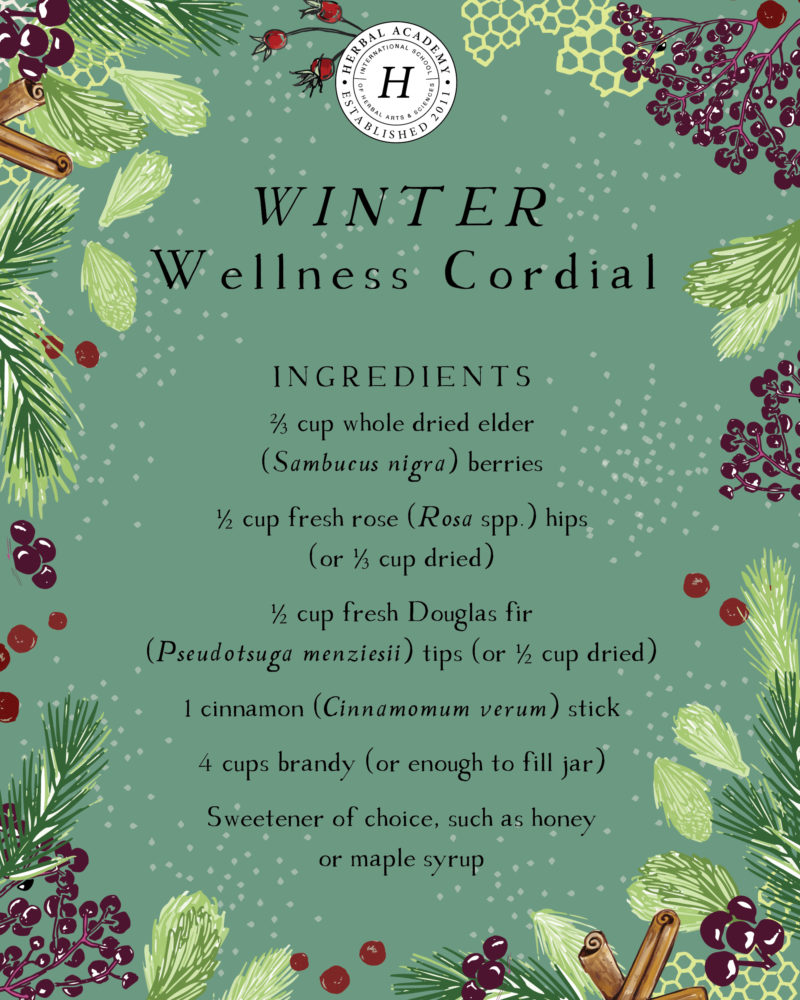
Winter Wellness Cordial
This Douglas fir conifer cordial recipe will help to stimulate and support the immune system with contributions from elderberries and vitamin C-rich Douglas fir tips and rose hips.
⅔ cup whole dried elder (Sambucus nigra) berries
½ cup fresh rose (Rosa spp.) hips (or ⅓ cup dried)
½ cup fresh Douglas fir (Pseudotsuga menziesii) tips (or ⅓ cup dried)
1 cinnamon (Cinnamomum verum) stick
4 cups brandy (or enough to fill jar)
Sweetener of choice, such as honey or maple syrup
Each of these recipes can be prepared according to the following directions.
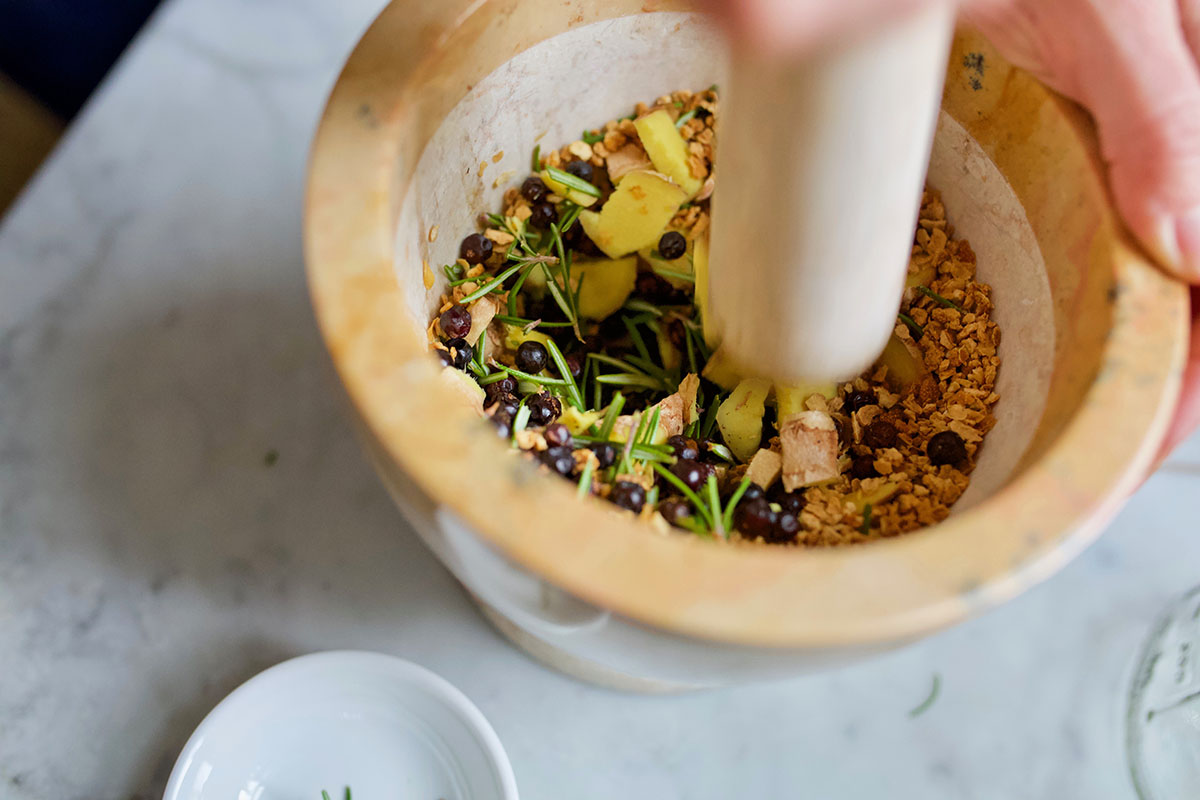
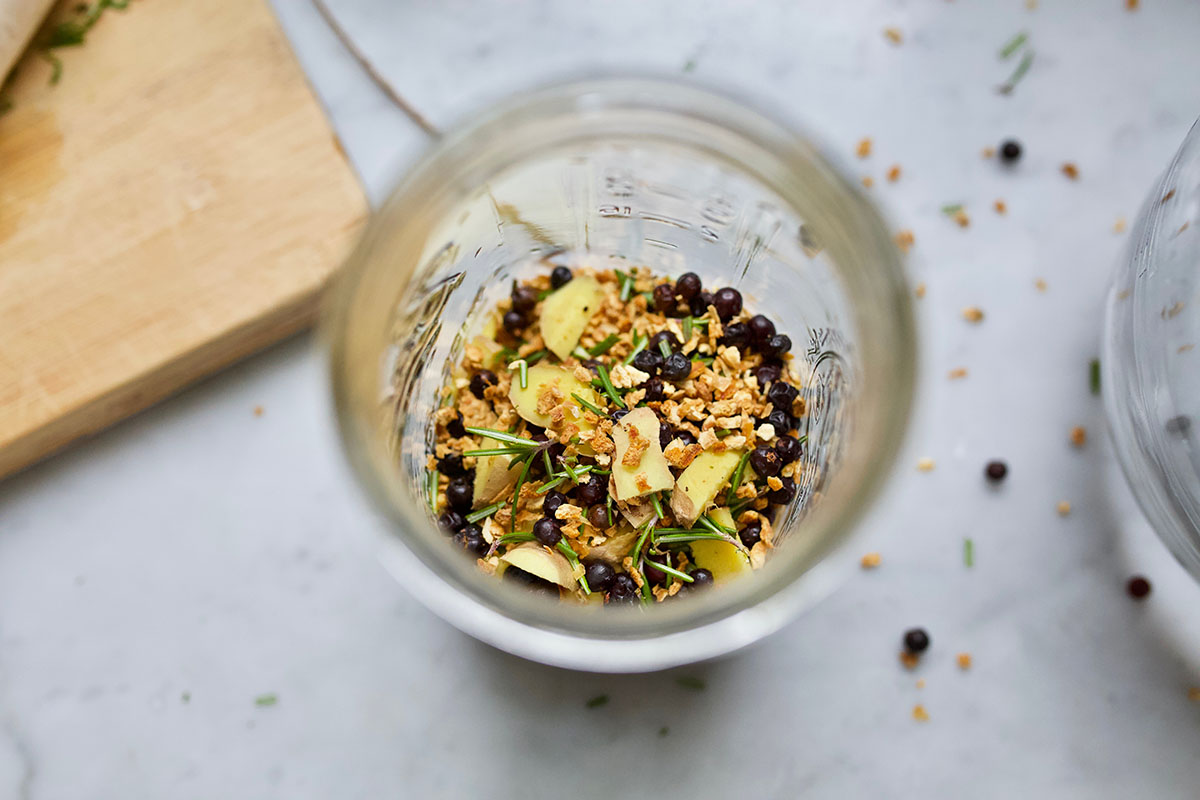
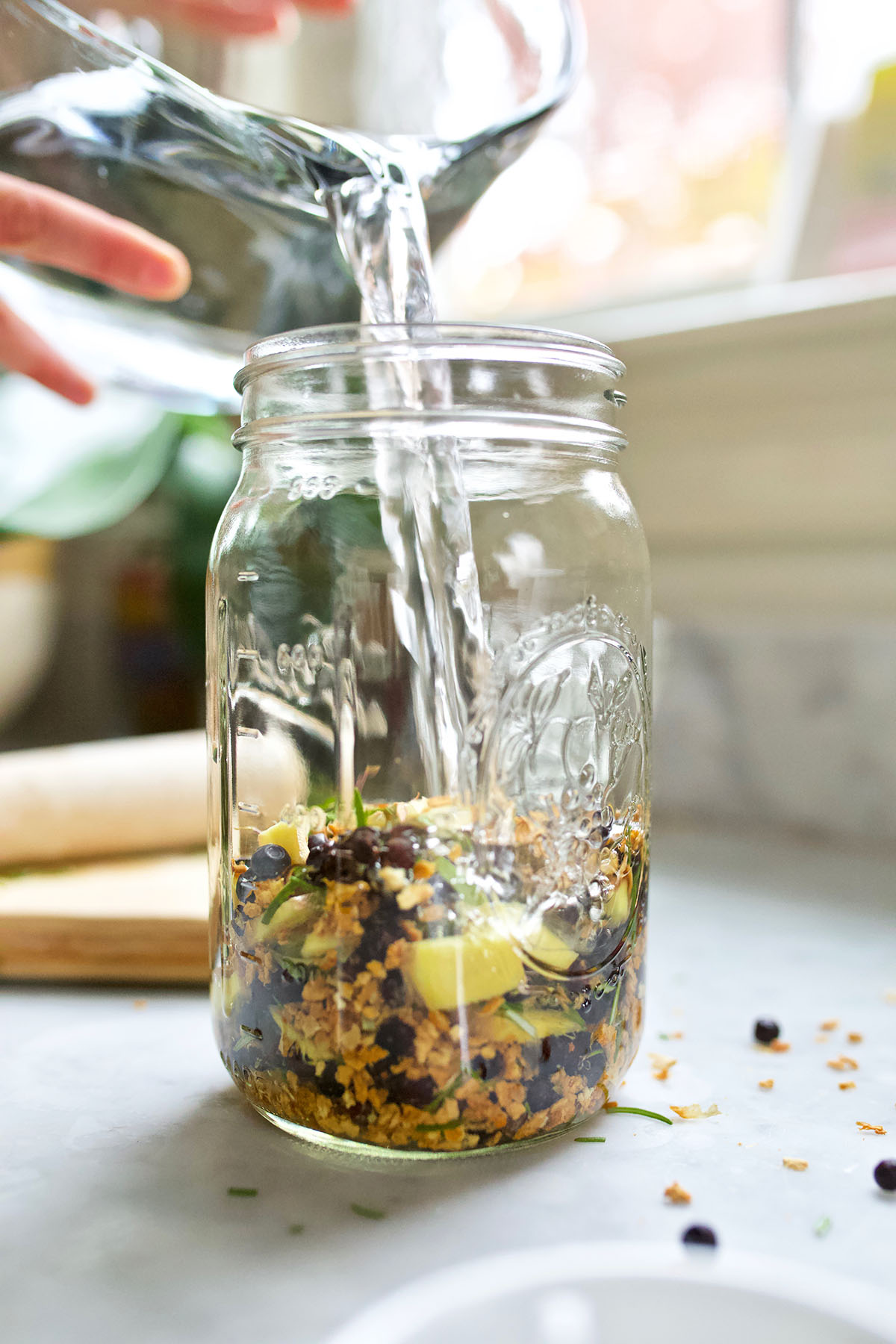
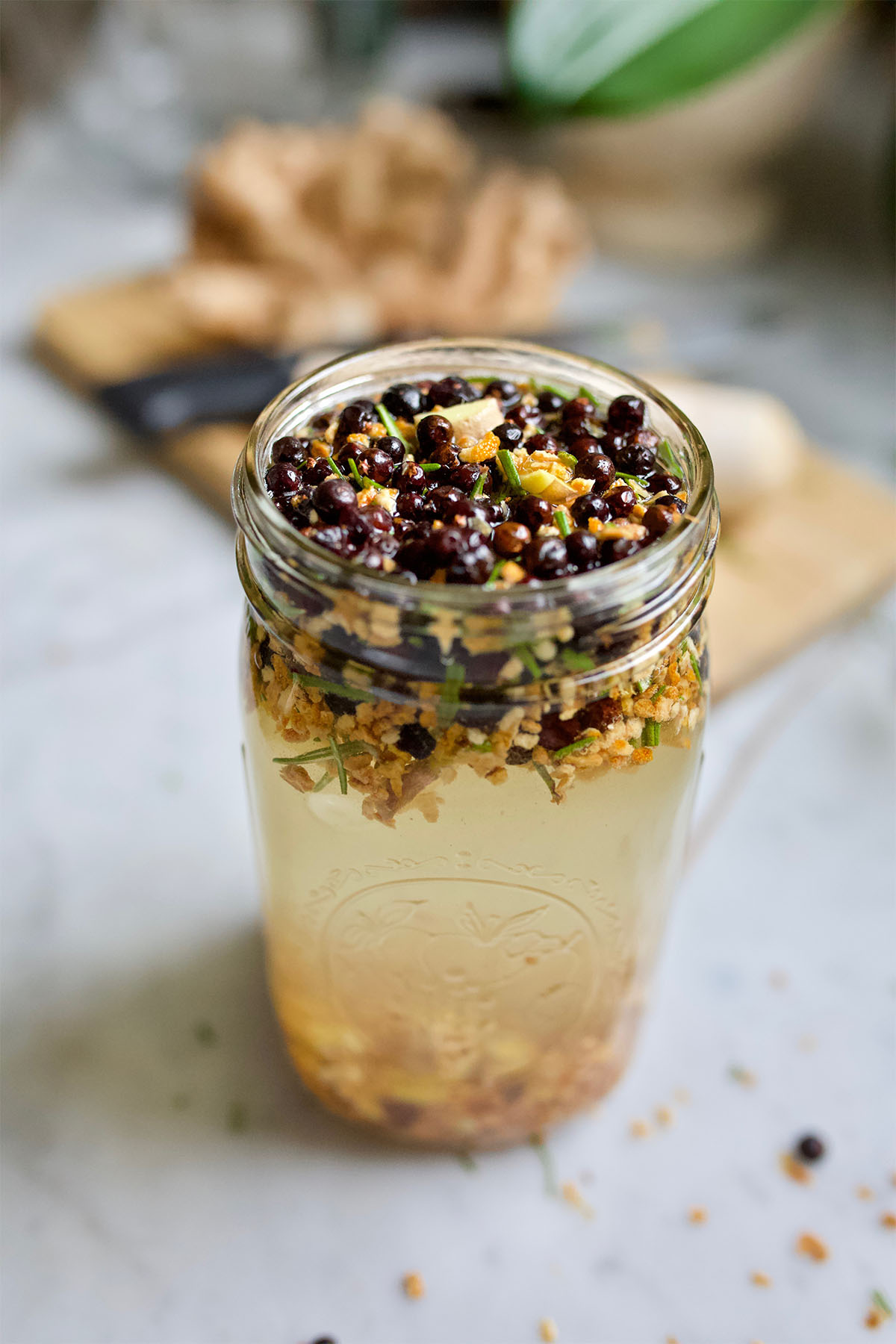
How to Make a Conifer Cordial
Adapted from The Herbal Kitchen by Kami McBride
- Prepare the ingredients by finely chopping fresh herbs with a knife or grinding dried herbs using a mortar and pestle.
- Fill a clean glass canning jar with the herbal ingredients.
- Pour the alcohol over the herbs, covering them by at least 2 inches of alcohol.
- Put a lid on the jar, label it with the contents and date, and store in a cool, dark place to infuse for 1 month. Check it every few days, give it a shake, and make sure that the ingredients remain covered by the alcohol, and if they are not, add more alcohol until they are covered.
- After 1 month, strain the ingredients into a new, clean jar using layered cheesecloth, a muslin cloth, or a fine wire sieve. Compost the used herbs.
- Traditionally, ½ part sweetener is added to 1 part tincture to make a cordial. Measure the volume of the tincture and combine with add half that amount of sweetener. You may use honey, herb-infused honey, maple syrup, rice syrup, or make your own simple syrup. Stir to combine.
- Store in a tightly sealed bottle or jar in a cool, dark place.
Preparing for Winter
As winter approaches, the plants start to wither around us in concert with the cycle of nature’s seasons. The evergreens remain, however, and are available to support us throughout the winter months. Conifers have many wellness benefits as stated above, and we hope you now feel inspired to incorporate these herbal allies into your life this year by making some conifer cordials for winter wellness!
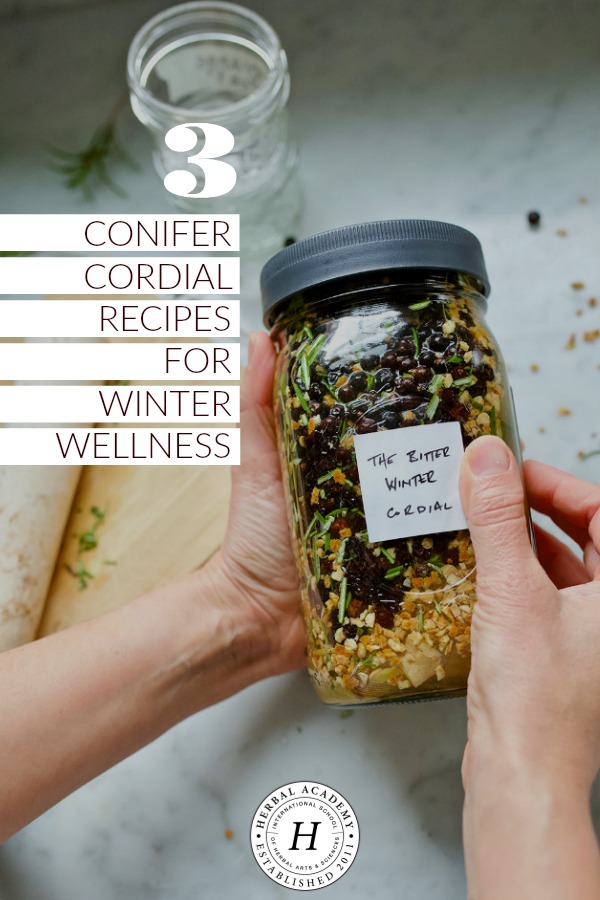
REFERENCES
American Conifer Society. (2017). What is a conifer tree? Retrieved from https://conifersociety.org/conifers/articles/what-is-a-conifer-tree/
Kloos, S. (2017) Pacific Northwest medicinal plants: Identify, harvest, and use 120 wild herbs for health and wellness. Portland, OR: Timber Press.
Langenheim, L. (2018). Plant resins: Chemistry, evolution, ecology, ethnobotany. Portland, OR: Timber Press.
Lassoie, J., Luzadiz, V., & Grover, D. (Eds.). (1996). Forest trees of the Northeast. Ithaca, NY: Cornell Cooperative Extension.
McBride, K. (2019) The herbal kitchen: Bring lasting health to you and your family with 50 easy-to-find common herbs and over 250 recipes. Newburyport, MA: Conari Press.
Moore, M. (1993). Medicinal plants of the Pacific West. Santa Fe, NM: Museum of New Mexico Press.
Native American Ethnobotany. (n.d.). Native American ethnobotany database. Retrieved from http://naeb.brit.org
Pursell, J.J. (2015). The herbal apothecary. Portland, OR: Timber Press.







